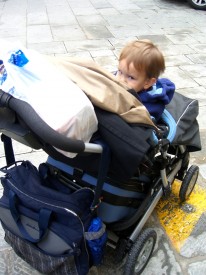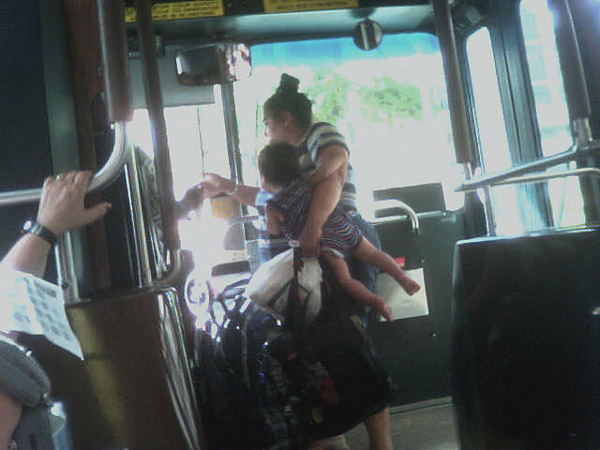Earlier this year, I shared my stroller-on-the-bus hell story. The villain in the tale was surprising: King County Metro, otherwise a hero in my book. Like many transit agencies across North America, Metro says kids cannot stay in their strollers on board buses—and that policy is a giant problem for families with babies and toddlers. Unpacking a stroller, folding it, and hauling everything onto a transit vehicle even one time is enough to convince many parents never to attempt a bus ride again.
Well, guess what? Dozens of Metro drivers on dozens of Metro buses already welcome aboard moms and other caregivers pushing their kids in prams: no stroller folding necessary. No rogue pram guerrillas, these drivers do so in accordance with their orders from above. So do certain drivers at the county transit agency in neighboring Pierce County, which also bans loaded strollers.
Contradiction? No. Sound Transit, the Puget Sound regional express bus service provider, has strong pro-stroller policies on most of its vehicles, including not only its light-rail cars but also most of its buses. (Exceptions are the tall, narrow-aisled, Greyhound-like vehicles it sends up and down I-5.) And Sound Transit contracts with King County Metro and Pierce Transit to operate its buses.
All that Metro and Pierce Transit need to do to catch up with North America’s stroller-friendly leaders is to tell all of its drivers to do what some of its drivers already do: follow Sound Transit’s stroller rules.
Specifically, Sound Transit, like greater Vancouver, BC’s TransLink, lets strollers roll aboard buses and trains. Strollers are allowed in the priority seating area at the front of the bus. Drivers have discretion to ask that a stroller be folded if it is creating a hazard. TransLink sets size limits. Both agencies prioritize the front seats: disabled riders get first dibs, followed by elderly riders, and finally caregivers with strollers.
Such rules are reasonable and, in fact, standard. Agencies with pro-stroller policies still set limits. A 2011 Transportation Research Board report indicates that 65 percent of transit agencies with stroller policies require strollers to park in a specific location. Sixty-three percent of agencies require strollers to be collapsible (but not necessarily collapsed).
Examples of pro-stroller policies dot the map of North America. Just north of King County, Snohomish County’s Community Transit allows loaded strollers aboard, although its policy is not well defined on its website. In 2006, Tri Delta Transit of Contra Costa, California, retrofitted its bus fleet to create stroller areas on board. San Francisco Muni recently began discussing lifting its stroller ban to “keep families from fleeing the city.”
Safety is often cited as a key reason for banning open strollers on buses. Yet many agencies address safety concerns with simple policies. The Chicago Transit Authority allows children to stay in strollers while riding transit, but they must be seated and secured; other agencies specify that strollers must have brakes activated. In Montreal, caregivers must face strollers towards the rear of STL buses. And the Alameda-Contra Costa Transit District specifies that the caregiver must keep a hand on the stroller while the bus is moving.

Transit agencies in King and Pierce Counties have examples of pro-stroller policies all around them. They would do well to copy from the playbooks of other transit agencies: set clear size limits, designate stroller space, and prioritize use of that space for different groups of riders. Then, let unfolded strollers roll aboard.
That’s all it would take to start giving moms, dads, and other caregivers the kind of treatment that makes transit a viable option for them.
Guest blogger Alyse Nelson is a city planner for a small town in Kitsap County, Washington. She spends some of her spare time researching for Sightline on topics such as pedestrian carts, cargo bikes, and family-friendly courtyard housing.


Comments are closed.